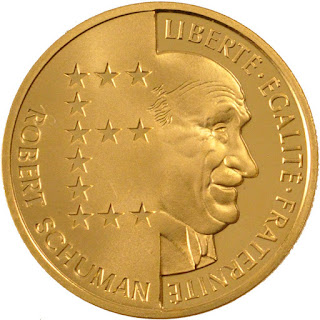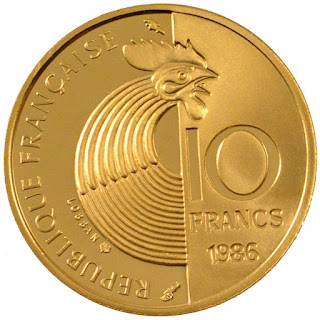French Gold Coins 10 Francs 1986 Robert Schuman
Commemorative issue: 100th Anniversary of the Birth of Robert Schuman
Obverse: on the right side head of French politician Robert Schuman facing right; on the left side letter E composed of 12 five-pointed stars - symbol of the European Union; along the right edge motto of France: LIBERTÉ • ÉGALITÉ • FRATERNITÉ (liberty, equality, fraternity), along the bottom left edge with concave lettering: ROBERT SCHUMAN.
Lettering: LIBERTÉ·ÉGALITÉ·FRATERNITÉ ROBERT SCHUMAN.
Engraver: John Lobban.
Reverse: in the coin centre stylised neck and head of a Rooster - one of symbols of France; on the right in two lines concave face value: 10 FRANCS, below concave year of issue 1986; along the left edge: RÉPUBLIQUE FRANÇAISE (French Republic).
Lettering: RÉPUBLIQUE FRANÇAISE 10 FRANCS 1986 LOBBAN.
Engraver: John Lobban.
Designer: Atelier de gravure (group of designers of the Paris Mint - rosette below rooster's neck in the obverse) based on design of John Lobban (signature LOBBAN along the rooster's neck in the obverse).
Mint: Paris Mint mark La Monnaie de Paris (The Paris Mint), Pessac (mint mark before RÉPUBLIQUE in the obverse, after FRANÇAISE privy mark of mint's director Émile Rousseau - dolphin).
Face value: 10 Francs.
Composition: Gold.
Fineness: 0.920.
Weight: 7.0000 g.
AGW: 0.2070 oz.
Diameter: 21 mm.
Robert Schuman
Robert Schuman (born June 29, 1886, Luxembourg — died Sept. 4, 1963, Metz, France), Luxembourgian-born French statesman who founded the European Coal and Steel Community and worked for economic and political unity designed to lead to the establishment of a “United States of Europe.”
Schuman, a member of the French National Assembly from 1919, was arrested by the German Gestapo in September 1940 after the German occupation of France. He escaped in 1942 and worked in the Résistance until France was liberated (1944). A founder of the Popular Republican Movement (Mouvement Républicain Populaire; MRP), he served as minister of finance (July–November 1946), premier (November 1947–July 1948 and August–September 1948), foreign minister (July 1948 – December 1952), and minister of justice (1955–1956).
While foreign minister he developed the Schuman Plan (1950) to promote European economic and military unity and a Franco-German rapprochement to prevent another war between the two nations. The economic aspects of his plan were realized in 1952 in the European Coal and Steel Community, a six-nation western European economic union, the first in a series of economic agreements leading to the formation of the European Economic Community (Common Market) in 1958. He served as president of the Common Assembly, the consultative arm of the Common Market, from 1958 to 1960 and was an Assembly member until February 1963.

